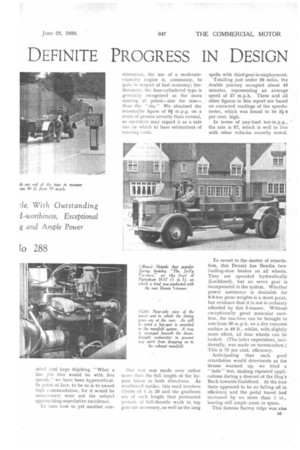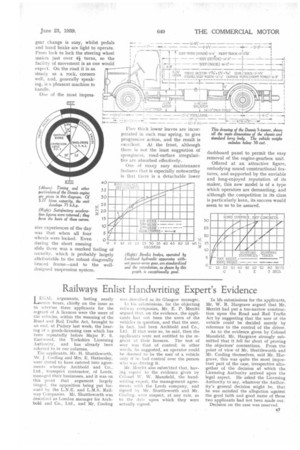NEW DENNIS 5-TONNER DENO', DEFINITE PROGRESS IN DESIGN
Page 38

Page 39

Page 40

Page 41

If you've noticed an error in this article please click here to report it so we can fix it.
Maximum-load 30 m.p., Characteristics of Gene Braking, Economica, :le, With Outstanding 1-worthiness, Exceptional g and Ample Power
Road lo 288
WE announced in our issue dated June 9 that a new 5tanner had just been added to the Dennis range. We are now able to give our readers an account of its performance. The vehicle is the largest model in the 50-cwt. unladen class made by Dennis Brothers, Ltd., and, in actual carrying capacity, ranks among the biggest on the British market in respect of weight of load.
In respect of platform area in relation to overall length, it is, we believe, at least the equal of any other virtually normal-control type. This phrase is used deliberately, because a modern tendency is to extend the cab to a varying degree into the bonnet, as it were, or to let the rear of the engine protrude into the driving compartment, thus gaining body space without material loss of cab space and without bringing the driver too adjacent to the power unit.
On this new Dennis little more than the part housing the pedals is beside the cylinder block, but the latter is closer to the radiator than usual, because of the maker's practice of positioning the timing gear at the rear. Accordingly, there are a short bonnet, a tolerably commodious cab, and over 13 ft. of body space, whilst the overall length is only 20 ft. for a wheelbase of 13i ft.
With but 6 ft. of overhang to share between front and rear, the designer has been able to arrive at a layout that not onry looks right, but also results, in fact, in a vehicle
possessed of exceptional road-holding properties. Full advantage, moreover, may he taken of these, because the brakes really are first-class.
Weighing altogether, on the occasion of our test, 8 tons 13i cwt., the vehicle is powered. by an engine developing 75 b.h.p., so the powerto-weight ratio is only 0.432. This, in our opinion, is slightly on the low side, but, in amelioration, the unit has excellent slogging powers.
As readers can see from an accompanying graph, acceleration is satisfactory, but the pick-up from 10 m.p.h. in top gear is a little sluggish, and at 30 m.p.h., cruising, a gradient such as that of the Guildford By:pass (1 in 26) calls for third gear. Here again, however, there is a mitigating
factor, namely, that the third-speed wheels are in constant-mesh and run notably silently.
A five-speed gearbox, incorporating an overdrive, is offered as an alternative, at slight extra cost, to the four-speed box on this model, and, perhaps, because we had this fact in mind and kept thipking "What a fine job this would be with five speeds." we have been hypercritical. In point of fact, to be so is to award high commendation, for it would be unnecessary were not the subject approaching superlative excellence.
To turn now to yet another con
sideration, the use of a moderatecapacity engine is, commonly, to gain in respect of fuel economy; furthermore, the four-cylindered type is generally recognized as the more sparing of petrol—size for size— than the " six." We obtained the reasonable figure of 91 m.p.g. on a route of greater severity than normal, so operators may regard it as a safe one on which to base estimations of running costs.
Our test was made over rather more than the full length of the bypass taken in both directions. As mentioned earlier, this road involves climbs of 1 in 26 and the gradients are of such length that protracted periods of full-throttle work in top gear are necessary, as well as the long
spells with third gear in employment.
Totalling just under 20 miles, the double journey occupied about 45 minutes, representing an average speed of 27 m.p.h. These and all other figures in this report are based on corrected readings of the speedometer, which was found to be 3I-4 per cent. high.
In terms of pay-load ton-m.p.g., the rate is 57, which is well in line with other vehicles recently tested.
To revert to the matter of retardation, this Dennis has Bendix twoleading-shoe brakes on all wheels. They are operated hydraulically (Lockheed), but no servo gear is incorporated in the system. Whether power assistance is desirable for 8-9-ton gross weights is a moot point, but evidence that it is not is certainly afforded by this 5-tonner. Without exceptionally great muscular exertion, the machine can be brought to rest from 30 m.p.h. on a dry concrete surface in 40 ft., whilst, with slightly more effort, all four wheels can be locked. (The latter experinient, incidentally, was made on tarmacadam.) This is 75 per cent. efficiency.
Anticipating that such good retardation would deteriorate as the drums warmed up, we tried a " fade' test, making repeated applications during a descent of the Hog's Back towards Guildford. At the foot there appeared to be no falling off in efficiency and the pedal travel had increased by no more than 1 in., leaving still ample room to spare.
This famous Surrey ridge was also used for hill-climbing trials. Ascending from Puttenham, where the gradient is 1 in 7, we made a non-stop run, the speed falling from 10 m.p.h. to 5 m.p.h., when the lowest ratio was engaged and rising again to practically the initial figure.
Following this, we came up from the other side of the Hog's Back, by the steeper slope of 1 in 61, and paused just short of the summit. Here we ascertained that the hand brake could easily check the vehicle when running back, and that a restart could be made with ease. So easily, in fact, was it accomplished, that we tried to repeat the performance in "second." This, however, proved to be asking too much of the machine.
Immediately after these climbs a thermometer reading was taken and the radiator water was found to be 150 degrees F.-88 degrees F. above the temperature of the air.
In the former connection, a word about the clutch is appropriate. Almost unique in this respect, it runs in oil, having a disc faced with special fabric for the purpose. It is extremely sweet, and, in no circumstances could we produce a trace of judder. It will start the vehicle from rest in top gear on the level with only moderately careful handling. Being l3i ins, in diameter, it should be of more than adequate size.
During our acceleration tests, 40 m.p.h. was only just exceeded, but this is not the limit of the vehicle's speed capabilities. In view of the fact that it reached 31 m.p.h. in third gear, it should be doing 50 m.p.h. at peak engine "revs."
Due, no doubt, to the rubber engine mountings, which permit considerable freedom of movement, vibration is almost absent throughout the crankshaft speed range, but there is detectable a slight thud at certain combinations of r.p.m. and torque_ As the unit is anchored by a torque rod, insulated by rubber at both ends, this is rather hard to explain. It is, however, so slight as to be a matter of no moment, and may have been an isolated case, characteristic only of the vehicle we tested.
In, addition to the cushioning, steps have been taken to eliminate vibration by counterbalancing the crankshalt and incorporating a damper in the transmission line.
As is usual in Dennis products, the chassis has much to commend it from the point of view of the driver. The
gear change is easy, whilst pedals and hand brake are light to operate. From lock to lock the steering wheel makes just over 41 turns, so the facility of movement is as one would expect. On the road it is as steady as a rock, corners well, and, generally speaking, is a pleasant machine to handle.
One of the most impres sive experiences of the day
was that when all four 5
wheels were locked. Even 0
during the short ensuing 0 5 slide there was a marked feeling of :ecitrity, which is probably largely attributable to the robust diagonally braced frame—and to the welldesigned suspension system. 11 Five thick lower leaves are incorporated in each rear spring, to give progressive action, and the result is excellent. At the front, although there is not the least suggestion of sponginess, road-surface irregularities are absorbed effectively.
One of many easy maintenance features that is especially noteworthy is that there is a detachable lower dashboard panel to permit the easy removal of the engine-gearbox unit.
Offered at an attractive figure, embodying sound constructional features, and supported by the enviable and long-enjoyed reputation of its maker, this new model is of a type which operators are demanding, and although the competition in its class is particularly keen, its success would seem to us to be assured.












































































